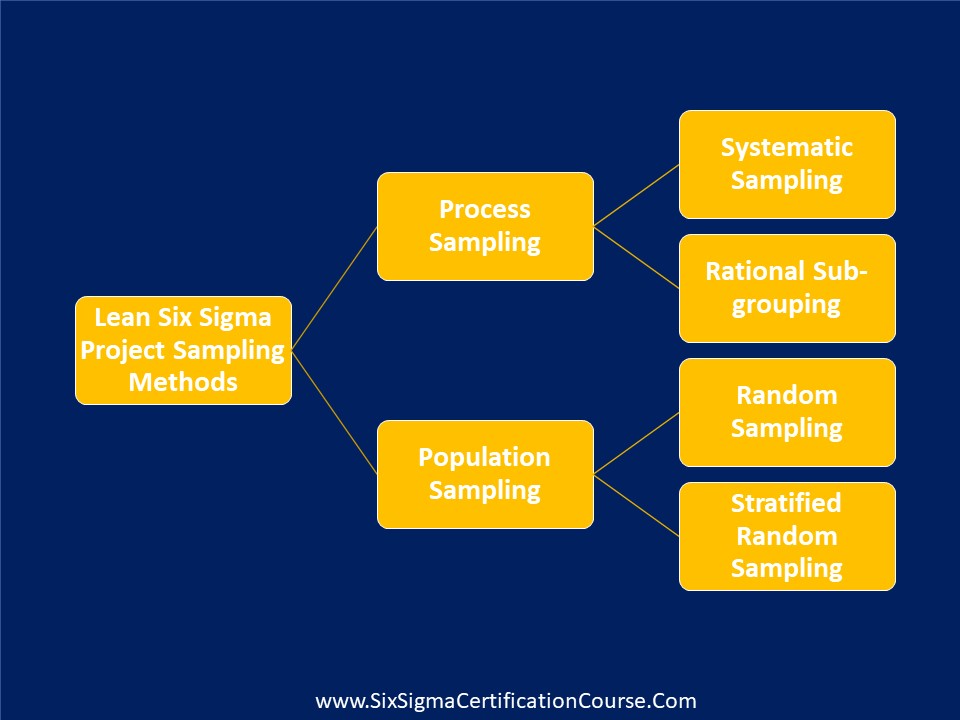We talked about the need for Lean Six Sigma project selection in detail in the earlier articles, in this one we’ll cover the criteria for selection and the in the following article, we’ll move on to talk about the tools used for selection and how to engage the stakeholders in the process.
I have found that while leaders agree on the need for project selection, their views on the criteria is quite divergent. Most of them see this as a process to sway the process in favor of their priorities and interests.
There is nothing wrong in doing so, as long as the process is not biased.
Through this article, we draw consensus on the criteria and its relevance to the whole process.
The real good news is that the criteria for getting the project selection right are not too complicated.
What does project selection countdown look it? We’re going to start with the least of the top 5 criteria and find our way to the top most criteria.
Here you go:
7. Probability of Success:
Not all the projects will be successful in any company. Hence, while selecting the project, most project leaders consider the contingencies which might come up and use that as a yardstick to select the project. Sponsors want their project leaders to be successful equally as projects leaders’ desire success. Well, sounds like a good approach. But doesn’t this approach make it very orthodox? Unlike other implementation projects in technology, improvement projects are bound to have ups and downs; and it is quite natural that not all projects achieve their goals. That is what continuous improvement is all about.
Thus choosing to play it safe isn’t the best criteria to select projects, though unfortunately, it is very popular criteria in use. That is why Probability of Success is the last in our countdown list! One of the organizations flips these criteria to select the project which has failed in the past or have a low probability of success as Black Belt project. That is certainly a best practice to emulate.
6. Availability of Data:
Is data readily available for the project? If not, can it be easily gathered? While most project leaders and sponsors know that rarely will all the data needed for a project is waiting around to be analyzed. But they use the availability of data criteria to select projects because the unreasonable expenditure of time, resources and effort can be avoided. Yes, data is needed for analysis. But making it a criterion reduces the scope Continuous Improvement deployment.
Improvement projects are expected to venture into unchartered territories of the process and present root cause and opportunities. Getting people to measure something that is not being reported till now, in it is a feat. Having vanilla project can hardly be a criterion for project selection. That is why the availability of data comes second last in our countdown!

5. Savings potential:
Any project implemented, is implemented with an intention to gain any kind of tangible or say monetary benefits. But along with monetary benefits, there are other benefits like customer satisfaction, increased efficiency, total company involvement; increases workspace and much more. While it is absolutely apt to select projects which have savings to the organization, it is misleading to make saving potential a primal purpose of projects. I have seen many times, project leaders come up with simple ideas or improvements with a huge saving potential to the organization, but virtually no complexity involved. Such projects hardly qualify for Black Belt projects.
They best serve as Just Do It project. Giving undue importance to saving potential in project selection also sends the wrong message across the organization. That is why I not really excited about having this as a top item in the countdown. That’s why Saving Potential is only Number 5 in our countdown.
4. Apt Time:
There is always a perfect timing to initiate a project. Relevance is contextual. By apt timing, I mean both the time to commence, and the closure as per plan. An important project has to close on time. It has to be first of all, planned to close on time. It has to be scoped to close on time. That is why Apt Time is No.4 in our countdown.
3. Availability of Resources:
I don’t know if this has to do with the culture. Most organizations, if not all, end up with a laundry list of projects because everything seems to be Business or Customer priority. Even the biggest and richest of the organizations have limited resources. Either resource is depleted, busy elsewhere or simply not committed to deliver. The best person is often leading many projects, making everything he/she does venerable to failure. Project selection is about de-selection and not selected. Ruthlessly put ideas into a parking list for which right resources are not available; and if it is so important that it has to be executed now, then pull the right resource into this project rather than sharing.
While I have largely kept this point around manpower, it equally applies to money & time. I say with conviction that organizations that ensure that the leader of the Lean Six Sigma project is a dedicated resource, either full time or handling only one project even if it means he is part time on it are surely successful. This is why Availability of Resource is No.3 on our countdown!
2.Customer impact:
Ask yourself “will the results of the project bring any difference in the life of the customer? Will it improve the perception of the customers about the quality of your product or services?” Quite often this answer to this question is yes. Unfortunately, it’s motherhood in apple pie question. So insist on quantifying the impact.
If you can pin a number to the impact, then go ahead. And if you’re not able to do so, then there’s no point in wasting your time on the project. Consider Voice of the Customer in your organization as a starting point. Why don’t you start with complaints and alleviate customer pain? Thus Customer Impact is Number 2 in the countdown.
1.Business Priority:
Selection of projects is based on the need or priority of the business. Project leaders need to understand that the tail can’t wag the dog. Often, people package their ideas into a project and fuel it as an organizational priority. Scanning of the external and internal environment will give first-hand insight on what is the organizational priority, NOW? Go for it. Well, that may put you out of your comfort zone, competency or expertise, but remember that’s what the organization needs.
Without a real need, do you think any leader would offer sponsorship to your project or will it at all help anyone – NO.? That is why Business Priority is Number 1 in our countdown.
Project Selection and implementation of Lean Six Sigma is easy and at the same time should be handled delicately by keeping all the above aspects in mind otherwise it might turn into a big disaster. An effective diagnostic study is required before selecting projects and with the undivided involvement of the top management are pre-requisites for project selection.
Tags
As we all know that there are different levels of certification in Lean Six Sigma and these levels have been associated with “Belt” titles. It’s a very obvious question that why the levels here have been associated with the titles used in Martial Arts? That is because of the association of discipline and rigor in Lean Six Sigma similar to the martial arts.
You would find four commonly used belt titles in Six Sigma Certification and they are Yellow Belt, Green Belt, Black Belt and Master Black Belt. However, the most basic level in Lean Six Sigma is sometimes called as “White Belt”. A White Belt understands the theoretical aspects but virtually no application knowledge of the Lean Six Sigma concept. One could say this is an entry level awareness program. Let us understand one by one, the four belts mentioned above.
- Yellow Belt: A Yellow Belt is someone who has undergone a basic training program that is may be a day’s training with a basic level of understanding of the quantitative part of the concept. He or she is able to appreciate the goals of Lean Six Sigma. Having knowledge of Yellow Belt level means that person is able to apply basic tools in the company and undertake simple improvement projects. Usually the organization who wants to implement Lean Six Sigma wants all their employees to be at least Yellow Belt trained as this makes the implementation and change management easier and faster.
- Green Belt: Lean Six Sigma Green Belt receives a training of at least one week with emphasis on DMAIC method and tools. DMAIC is problem solving methodology which stands for Define, Measure, Analyze, Improve, and Control through which he/she is able to undertake improvement projects in his/her process which improves customer satisfaction and efficiency of the process. Green Belts are also called as “Work Horses” having the following responsibilities:
- Initial analysis of company like Gemba Walk and Data Analysis which will be helpful in defining the road map of the project.
- Define the project and prepare the project charter.
- All over co-ordination with management, yellow belts, black belts and master black belts.
- Facilitate the team through all phases of the project.
- Provide training to the team for effectiveness of the implementation.
- Black Belt: A black belt is someone who receives at least 3 to 4 weeks of extensive training with the emphases on DMAIC method and tools which is explained as above. Unlike a green belt, black belt is a full time role who has the responsibility to run large scale high impact improvement projects where he mentors and coaches green belts. Responsibilities of a black belt are listed as under:
- Helps in deciding the project.
- Helps in refining the project charter and makes sure that the things are moving in the desired direction.
- Leads, mentors and coaches green and yellow belts and champions.
- Empowers the team members to design experiments and analyse the data required for the project.
- Provide training in tools and team functions to project team members.
- Makes sure that the project succeeds.
- Maintains balance between Management, Employees and Customer’s needs.
- Manages the team for effectiveness and efficiency.
- Master Black Belt: It is usually a leadership role having excellent change management skills along with having good technical knowledge. After completion of the black belt course and having good experience he/she receives additional 3 to four weeks of training mostly around change management and statistics. MBB’s primary role is to deploy six sigma concepts in the organization, advice to executives or business unit managers, and leverages, his/her skills with projects that are led by black belts and green belts. A Master Black Belt reports the senior or top management and coaches the black belts and Green Belts. Responsibilities of Master Black Belts are enumerated as under:
- Provides guidance to senior executives and top level managers on Six Sigma management.
- Help identify and prioritize key project areas in keeping with strategic initiatives.
- Continually improve and innovate the organization’s Six Sigma process.
- Apply Six Sigma across both operations and transactions-based processes such as Sales, HR, IT, Facility Management, etc.
If you want to start your journey in Lean Six Sigma, its best you start by understanding some of the basics of Lean Six Sigma. Our Lean Six Sigma Primer Course is Free and it gives a great deal of information on Six Sigma. From there on you could more to Yellow Belt and Green Belt. This approach is pragmatic because it optimizes your investment of resources, time and effort.
Tags
Lean Six Sigma Project – A beginner’s guide is a series that explains how to run Lean Six Sigma projects in detail. The biggest benefit of combining Lean and Six Sigma is to deliver more value to customers and business. In order for a Six Sigma Green Belt to be successful with a project, they must know what’s to be done, and how to accomplish them! This guide is a step-by-step procedure to execute the 5 phases of a Lean Six Sigma project.
Lean Six Sigma improvement projects follow 5 phase DMAIC approach. A six sigma project is not an academic exercise, but its primary objective is to impact customers, business, and employees positively. Thus stakeholder buy-in and sponsorship are very important factors for its success. Every project should have at least one project sponsor (One sponsor is just fine, two is OK, but greater than that is undesirable). The project sponsor is usually the process owner or a senior management executive who is accountable for the overall project and its success. They take the lead in identifying the project & its objectives, and in team formation.
The team composition should be cross-functional. The sponsor also has to decide whether this Six Sigma project should be led by a Black Belt or Green Belt. Once identified, the respective Six Sigma Belt plays the lead role in the project. It is their responsibility to complete the project on time, and deliver desired results. Now, for the remaining part of this beginner’s guide, let’s assume that it is a Lean Six Sigma Green Belt Project.

The duration of a typical project should be between 3 to 4 months. The overall project plan for all Six Sigma improvement projects are mapped to Define, Measure, Analyze, Improve, and Control. There are defined deliverables for each of these phases which have to be accomplished before progressing further. At the end of each phase, a formal tollgate is used to stage a gate review by the sponsors. Various Six Sigma concepts and tools can be applied to progress and accomplish desired phase-wise outcomes.
In order to make sure the project meets the timeline, and set-out objectives; the Green belt and team members are to meet regularly. In addition to this, Six Sigma Green Belts are mentored by Black Belts or Master Black Belts.
In a nutshell, following are the broad outlines for each of the DMAIC phases of Lean Six Sigma Project:
- Define – Identify the project objective and define the problem to be solved
- Measure – Collect necessary data regarding the problem and establish current performance
- Analyze – Use the data collected to analyze and screen factors which are the root causes for a problem
- Improve – Identify suitable solutions to overcome the root causes
- Control – Implement the solutions and monitor its results
Next, as a part of this beginner’s guide, let’s understand how to accomplish the deliverable of the Define phase here. Next >>>
Tags
Six Sigma Certification gives power to employees to bring true business transformation. This in turn facilitates an enterprise to provide better products & services to its customers.
Any enterprise that certifies employees (or professionals) needs to have the necessary infrastructure such as: Six Sigma training curriculum, trainers, improvement projects, experts to mentor projects, certification criteria, etc.
Immaterial of the belt one wishes to acquire, Six Sigma Certifications can be broadly classified as follows:
- First Party Certification
- Second Party Certification
- Third Party Certification
First Party Six Sigma Certification
Large Enterprises often create their internal infrastructure to certify employees. This infrastructure should include: six sigma experts, trainers, training curriculum, project selection criteria, project mentoring/coaching model, and certification criteria to certify all deserving employees. This helps establish employees as having a class above the rest, thus improving creativity and productivity of quality goods or services. Some examples include GE, Caterpillar, Bank of America, etc.
Six Sigma Certification criteria, body of knowledge, and hence proficiency levels vary between different enterprises.
The value of such a first party certification is often tied to brand value of enterprises. Hence certificates from fortune 100 enterprises do carry a good deal of recognition in the market.
Second Party Six Sigma Certification
Companies that do not have the infrastructure to train their employees, or lack the expertise, will engage an agency to assess and certify employees. Companies leverage the agency’s infrastructure and credibility to issue co-branded certifications.
However, co-branded Six Sigma certifications often come under the scanner, as agencies might be obliged to certify employees purely out of business compulsions.
Third Party Certification
Here employees get Six Sigma certification from an agency all by themselves. An employee will realize the potential of such a certification in today’s competitive job market, and drive him/herself to complete their certification.
The advantage with this type of certification is that it is a purely neutral certificate. Of course, the brand of agency matters and the employee will need to satisfy all criteria to get certified. Due to lack of a universal certification body, many agencies may have diluted certification standards. This makes it easy to receive a certification, but with little real value attached to it.
If you are looking for a six sigma certification, then, check your options. Consider the following:
- First Party Certification: You need to check if the employer’s brand is universally recognized and if it is a fortune 100 company.
- Second Party Certification: You need to check if the criteria used for certification is in line with the industry standard, and if there is enough hands-on exposure to six sigma tools and techniques.
- Third Party Certification: You need to check the training curriculum and content, industry specific examples, case studies, statistical software exposure, certification criteria, personal guidance, brand, etc., between various third party certifiers before selecting one.
A good trade-off will be to receive training from a reputed organization in fulfilling the above guidelines, and then take the Six Sigma Certification from an industry recognized body like ASQ. This way you get the best of both!






